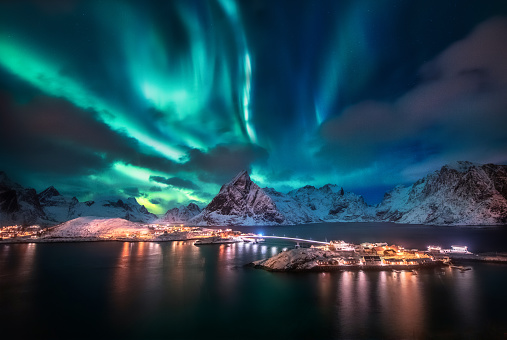Operation Nasa has uncovered the secrets of the phenomenon of space Aurors and their shape across the galaxy.
A special type of aurora, clad in the east-west night sky like a glowing pearl necklace, will help scientists better understand the science of auroras and their powerful drivers in space.
These are known as Aurora beads, these lights often appear just before large Aurora screens caused by electrical storms in space called sub-storms.
They are atmospheric phenomena consisting of light rays caused by charged solar particles after the Earth’s magnetic power lines.
If the planet has an atmosphere and a magnetic field, it is usually Aurora.
In the past, scientists were unsure whether aurora beads were somehow attached to other auroral displays as a pre-storm phenomenon in space, or whether they caused disturbances closer to the Earth’s atmosphere.

But powerful new computer models combined with observations of the time history of NASA events and macro-scale interactions during storms (THEMIS) have provided the first strong evidence of events in space leading to the appearance of these gems and shown that they play an important role in the space environment.
Offering a broader image than can be seen with just three THEMIS spacecraft or Earth observation, the new models have shown that Aurora spheres are due to plasma turbulence – the fourth state of matter, consisting of gaseous and highly conductive charged particles – surrounding the earth.
The results will ultimately help researchers better understand the turbulent structures seen in auroras, the researchers said.
Professor Vassilis Angelopoulos, director of THEMIS research at the University of California, Los Angeles, said: ‘Now we know for sure that the formation of these pearls is part of the process that precedes the launch of a substorm in space.
‘This is an important new piece of the puzzle.’
Aurora is formed when the charged particles in the sun are trapped in the Earth’s magnetic environment – the magnetosphere – and funnel into the Earth’s upper atmosphere, where collisions cause glow of hydrogen, oxygen and nitrogen atoms and molecules.
Auroras, as they are known, are created by the trapping of particles charged in the sun into the Earth’s magnetosphere (Credits: Getty Images)
By modeling the near-Earth environment on a scale of tens of miles to 1.2 million miles, THEMIS scientists were able to show details of how Aurora beads form.
Dr. Evgeny Panov, author of a new article and THEMIS researcher at the Austrian Academy of Sciences Institute for Space Research, said: ‘THEMIS observations have now revealed space turbulences that cause illuminating currents from the sky in the form of individual beads in a glowing Aurora necklace.
“These turbulences in space are initially due to lighter and more agile electrons that move with the weight of 2,000 times heavier particles and that could theoretically develop into full-scale auroral storms.”
As plasma clouds flowing through the sun pass through the earth, their interaction with the earth’s magnetic field creates floating plasma bubbles behind the earth.
Like a lava lamp, the imbalance in buoyancy between bubbles and the heavier plasma of the magnetosphere creates plasma fingers that are 2,500 miles wide and extend toward the Earth, according to the researchers.
The signatures of these fingers create a distinct pearl-shaped structure in Aurora, experts say.
Dr. David Sibeck, a THEMIS project researcher at the Nasa Goddard Space Flight Center in Greenbelt, Maryland, said: ‘It has been found that all of these relatively small transient events around the magnetosphere are somehow important.
‘We have only recently reached a point where computing power is good enough to capture basic physics data into these systems.’
Now that scientists understand that Aurora beads precede sub-storms, they want to find out how, why, and when the beads could trigger a complete sub-storm, the researchers said.
At least in theory, fingers can become entangled in the lines of a magnetic field and cause an explosive event known as magnetic reconnection, known to create full-scale substorms and auroras that fill the night sky, experts said.
Since its inception in 2007, THEMIS has made detailed measurements through the magnetosphere to understand the causes of sub-storms leading to the auror.

In its main mission, THEMIS was able to demonstrate that magnetic coupling is the primary driver of sub storms.
The new results highlight the importance of structures and phenomena on a smaller scale – hundreds and thousands of miles across compared to millions of miles.
Dr. Slava Merkin, author and researcher of a new article at the Nasa Geospace Storms Center, headquartered in the Laboratory of Applied Physics at Johns Hopkins University in Laurel, Maryland, said: ” To understand these features of Aurora, you really need to address both global and smaller local scales. That’s why it’s been so challenging so far.
‘It requires very sophisticated algorithms and very large supercomputers.’
The new computer simulations fit almost perfectly with THEMIS and field observations, according to the authors of the study.
After the initial success of the new computer models, THEMIS researchers are eager to apply them to other unexplained Aurora phenomena, they added.
In explaining small-scale structures in particular, computer models are essential because they can help interpret what is happening between the spaces in which THEMIS spacecraft pass, experts said.
Dr. Kareem Sorathia, editor and researcher of a new article at Nasa’s Geospace Storm Center, headquartered in Johns Hopkins Laboratory of Applied Physics, said: ‘In Aurora, people see a lot of very dynamic, very small-scale structures that are difficult to combine with the larger picture of space very quickly and on a very small scale.
” Now that we can use global models to describe and explore them, it opens a lot of new doors. ”
The results of the assignments were published in Geophysical Research Letters and the Journal of Geophysical Research: Space Physics.

